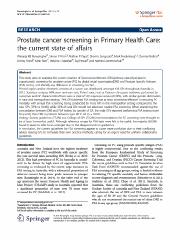Please use this identifier to cite or link to this item:
https://ahro.austin.org.au/austinjspui/handle/1/12658| Title: | Prostate cancer screening in Primary Health Care: the current state of affairs. | Austin Authors: | Ranasinghe, Weranja Kb;Kim, Simon P;Papa, Nathan P;Sengupta, Shomik ;Frydenberg, Mark;Bolton, Damien M ;Pond, Dimity;Ried, Karin;Marshall, Melanie J;Persad, Raj;Lawrentschuk, Nathan | Affiliation: | University of New South Wales, NSW (on behalf of PHReNet-GP, a Practice Based Research Network, University of New South Wales), Paddington, Australia University of Melbourne, Dept of Surgery, Olivia Newton-John Cancer Research Institute, Austin Hospital and Peter MacCallum Cancer Centre, Dept of Surgical Oncology, Melbourne, Australia University Hospitals Bristol NHS Trust, Bristol, UK Department of Urology, Monash Medical Centre, 823-865 Centre Road, Bentleigh, Victoria 3165 Australia Department of Urology, Monash Medical Centre, 823-865 Centre Road, Bentleigh, Victoria 3165 Australia ; Department of Surgery, Monash University, Melbourne, Australia Department of Surgery, Austin Hospital, University of Melbourne, Melbourne, Australia Yale University; Department of Urology; Cancer Outcomes, Public Policy and Effectiveness Research (COPPER) Center, New Haven, Connecticut USA ; University Hospital Case Medical Center, Case Western Reserve University School of Medicine, Urology Institute, Cleveland, Ohio USA University of Newcastle, Newcastle, Australia National Institute of Integrative Medicine, Melbourne, Australia |
Issue Date: | 13-Feb-2015 | Publication information: | Springerplus 2015; 4(): 78 | Abstract: | This study aims to examine the current practice of General practitioners (GPs)/primary care physicians in opportunistic screening for prostate cancer (PC) by digital rectal examination(DRE) and Prostate Specific Antigen(PSA) testing and identify any difference in screening practice. Printed copies and/or electronic versions of a survey was distributed amongst 438 GPs throughout Australia in 2012. Statistical analyses (Wilcoxon rank-sum test, Fisher's exact test or Pearson chi-square test)were performed by outcomes and GP characteristics.There were a total of 149 responses received (34%), with similar gender distribution in rural and metropolitan settings. 74% GPs believed PSA testing was at least 'somewhat effective' in reducing PC mortality with annual PSA screening being conducted by more GPs in the metropolitan setting compared to the rural GPs (35% vs 18.4%), while 25% of rural GPs would not advocate routine PSA screening. When examining the concordance between DRE and PSA testing by gender of GP, the male GPs reported performing PSA testing more frequently than DRE in patients between ages 40 to 69 (p = 0.011). Urology Society guidelines (77.2%) and College of GPs (73.2%) recommendations for PC screening were thought to be at least 'somewhat useful'. Although reference ranges for PSA tests were felt to be useful, the majority (65.8%) found it easier to refer to an urologist due to the disagreements in guidelines. In conclusion, the current guidelines for PSA screening appear to cause more confusion due to their conflicting advice, leaving GPs to formulate their own practice methods, calling for an urgent need for uniform collaborative guidelines. | Gov't Doc #: | 25713765 | URI: | https://ahro.austin.org.au/austinjspui/handle/1/12658 | DOI: | 10.1186/s40064-015-0819-8 | Journal: | SpringerPlus | URL: | https://pubmed.ncbi.nlm.nih.gov/25713765 | Type: | Journal Article |
| Appears in Collections: | Journal articles |
Files in This Item:
| File | Description | Size | Format | |
|---|---|---|---|---|
| 25713765.pdf | 442.65 kB | Adobe PDF |  View/Open |
Page view(s)
38
checked on Nov 16, 2024
Download(s)
112
checked on Nov 16, 2024
Google ScholarTM
Check
Items in AHRO are protected by copyright, with all rights reserved, unless otherwise indicated.
